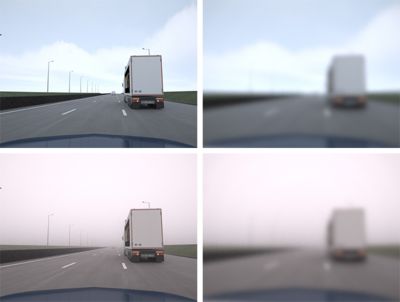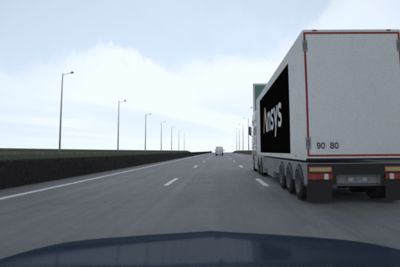-
-
학생용 무료 소프트웨어에 액세스하기
차세대 엔지니어에게 힘을 실어주는 Ansys
학생들은 세계적 수준의 시뮬레이션 소프트웨어를 무료로 이용할 수 있습니다.
-
지금 바로 Ansys에 연결하십시오!
미래를 설계하기
시뮬레이션이 다음 혁신을 어떻게 지원할 수 있는지 알아보려면 Ansys와 연결하십시오.
국가
무료 트라이얼
제품 및 서비스
학습하기
회사 정보
Back
제품 및 서비스
ANSYS BLOG
November 24, 2020
Why High-Performance Computing (HPC) Is Critical to Autonomous Vehicle Development
Autonomous vehicle technologies could not be developed and validated without high-performance computing (HPC) simulation. The lidar, camera and radar systems that enable autonomous vehicles require multiple redundant sensor systems that must be simulated for performance and safety.
Lidar is critical for self-driving cars because it provides an accurate point-cloud description of the surrounding area. A lidar system includes four major components: a laser pulse emitter, a retro reflected light receiver, a sensor and signal processing software.
A comparison of the camera perception in foggy and clear conditions,
considering deformations of the camera lens due to temperature
variations (ideal vs. worst-case temperature scenario). Clockwise
from top left: glass lenses,
low temperature, clear sky; plastic lenses, high temperature,
clear sky; plastic lenses, high temperature, ambient fog; glass lenses, low temperature, ambient fog.
Mono and stereo camera systems provide an accurate assessment of speed and distance. They also outline obstacles and moving objects. Thermal cameras can effectively detect and identify objects in darkness and through smog, inclement weather, shadows and sun glare, contrary to classic systems. Simulating these technologies during development enables future vehicles to successfully detect road hazards and respond in a timely, appropriate manner.
HPC simulation accelerates the design process of these systems by allowing cross studies to be performed faster and simultaneously. Additionally, open loop simulations can be used to test edge cases. Edge cases are rare situations that are unlikely to happen and so can be challenging to anticipate during the product development stage.
How HPC Simulation Powers Autonomous Vehicles Development
HPC enables simulation to transition from static results (a single picture) to dynamic results (video made from multiple frames) quickly and easily. It provides a tenfold calculation increase because there are no hardware limitations when calculating the optical perception of a sensor. This acceleration in getting the results enables engineers to test all possible combinations and worst-case scenarios to be sure the systems will pass certification.
The combined analysis approach enabled by HPC simulation gives confidence that no possible use case would be missed, whether it is caused by the product design or driving conditions. Weeks of calculation are reduced to minutes thanks to HPC. Faster calculations allow for faster decision making, which accelerates innovation. HPC is helping to bring automated driver assistance systems (ADAS) and fully autonomous vehicles to market faster.
Each line in this HPC scheduler is a simulation running on 128 distributed physical cores.
HPC Simulation Clears Up Foggy Autonomous Vehicle Development Challenges
How would a stereo camera perceive and interpret the presence of a person in thick fog? Through Ansys Speos, you can test the robustness of the algorithm and systems in front of various cases, including edge cases.
Without HPC, you can use Speos to create static images of fog. With HPC, you can recreate hundreds of cases to see the impact of various fog intensities on the camera perception in dynamic conditions, for combined analysis and optimization.
You can recreate what the two cameras perceive. You can then simulate whether their fusion correctly interprets the presence and distance of objects. This emulates what the future car will perceive and deduce to then take corrective driving actions.
Right and left images from stereo system
Distance calculation simulating 100-meter visibility in fog at 90km/h and
30 frames per second.
A Multiphysics Simulation Solution
HPC simulation opens the door to multiphysics by enabling you to easily combine and vary parameters, such as temperature, design options, materials, weather conditions, traffic conditions, etc. HPC enables you to gather all the necessary physics and still get detailed results quickly.
For example, you can model rain with Ansys Fluent and camera lens deformations and modifications with Ansys Mechanical Workbench. You can gather all this simulation data within a single project running on HPC to gain precious development time early in the process.
For more information, watch the “Optimizing Optical Design and Validation Workflows with Ansys Speos Lens System Importer” webinar.
As ADAS technologies become more robust and the industry advances to fully autonomous vehicles, simulation paired with HPC will allow engineers to test more cases — and more complex cases — quickly so that edge cases and what-if scenarios can be explored early in the product development cycle.


